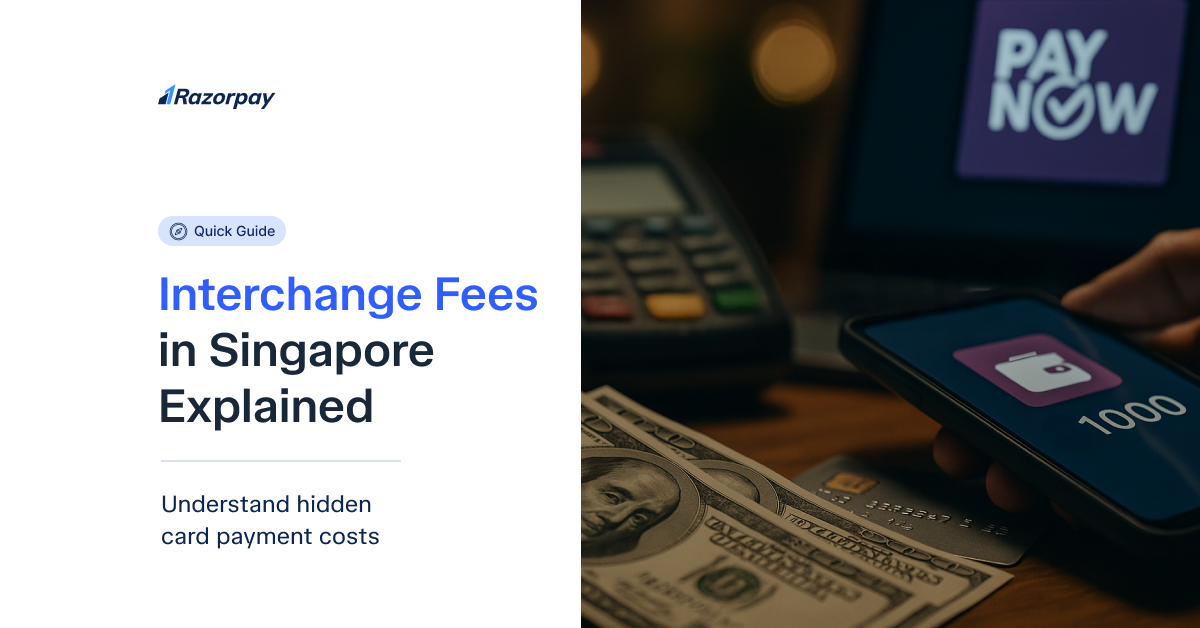For any business that accepts card payments, the Merchant Discount Rate (MDR) is a familiar cost. But within that single percentage lies a complex and significant charge that most merchants never see directly: the interchange fee.
This fee is the largest and least understood component of your payment processing costs, yet it plays a crucial role in the entire digital payment ecosystem. Understanding what it is, who it goes to, and why it changes from one transaction to the next is the first step toward truly managing your payment expenses and optimizing your revenue.
This guide provides a clear and comprehensive explanation of interchange fees for Singaporean businesses. We will break down how they work, what factors determine their cost, and how you can strategically manage their impact on your bottom line.
Key Takeaways
- What It Is: An interchange fee is a charge that a merchant’s bank (the acquirer) pays to the customer’s card-issuing bank (e.g., DBS, UOB) on every single card transaction.
- The Biggest Slice: It is the largest component of your Merchant Discount Rate (MDR), often accounting for 70-80% of the total fee.
- Who Sets It: Interchange rates are set by the card networks (Visa, Mastercard) and are non-negotiable for individual businesses.
- Why It Varies: The fee is dynamic and changes based on several risk factors, including the type of card used (e.g., credit vs. debit), the transaction method (online vs. in-person), and your business category.
- How to Manage It: While you cannot change the rates themselves, you can manage their impact by partnering with a payment platform that offers transparent, blended pricing and by encouraging the use of lower-cost payment alternatives like PayNow.
What is an Interchange Fee? A Clear Definition for Businesses
An interchange fee is a transfer fee paid between the banks involved in a card transaction. Specifically, it flows from your business’s bank (the acquirer) to your customer’s bank (the issuer) to compensate the issuer for its role in the transaction.
Think of it as a handling fee for the customer’s bank. It covers their costs and risks, such as:
- The risk of fraud and potential chargebacks.
- The cost of funding the interest-free period on a credit card purchase.
- The expense of funding customer rewards programs like cashback or air miles.
Business Example: A customer buys an item for S$100. Your total MDR is 2.7% (S$2.70). The interchange fee might be 1.8% (S$1.80) of that total. This S$1.80 is collected by your payment provider and paid directly to the customer’s bank.
How Interchange Fees Work: The Transaction Flow Explained
The interchange fee is exchanged during the settlement phase of a transaction. Here’s a simplified step-by-step look at the process:
- Customer Pays: A customer uses their credit card to pay S$100 at your online store.
- Authorization: Your payment platform sends a request for payment to the customer’s bank (the issuer) via the card network (e.g., Visa).
- Approval: The issuing bank checks for sufficient funds and fraud risk, then approves the transaction.
- Settlement: This is where the interchange fee comes in. During the nightly settlement process, your payment platform (the acquirer) pays the issuing bank the S100,∗∗minustheinterchangefee∗∗(e.g.,S1.80). So, the issuing bank receives S$98.20.
- Final Payment to You: Your payment platform then deposits the S100intoyouraccount,∗∗minusthefullMDR∗∗(e.g.,S2.70). You receive S$97.30.
Who Sets the Interchange Rates and Why?
Interchange rates are set by the card networks, primarily Visa and Mastercard. These rates are published publicly but are incredibly complex, with hundreds of different categories.
The networks set these fees to create a balanced ecosystem. The interchange fee provides a revenue stream for issuing banks, which incentivizes them to issue more cards to consumers. This, in turn, creates a larger pool of potential customers for merchants, driving more sales. It’s the economic engine that makes the global card system work.
Key Factors That Determine the Cost of an Interchange Fee
The exact interchange fee charged for a transaction is not random. It is calculated based on a specific set of risk-related variables.
- Card Type: This is one of the biggest factors. A premium rewards credit card has a much higher interchange fee than a basic debit card because the issuing bank has higher costs (funding rewards) and assumes more risk.
- Transaction Method: “Card-Not-Present” (CNP) transactions, such as those online or over the phone, have higher interchange fees than “Card-Present” (CP) transactions, where a card is physically tapped or inserted. This is because the risk of fraud is statistically higher when the card isn’t physically present.
- Merchant Category Code (MCC): Every business is assigned an MCC, a four-digit number that classifies its industry. A supermarket (low-risk) will have a lower interchange rate than an online travel agency (higher risk of cancellations and chargebacks).
- Card Brand: Visa, Mastercard, and American Express each have their own schedules of interchange rates.
Did You Know?
The concept of interchange was born from a legal dispute in the 1970s. A bank that issued a new financial product called a “credit card” decided it shouldn’t have to bear all the risk and cost.
The resulting fee structure, interchange, was designed to spread the cost and incentivize more banks to join the system, ultimately leading to the global adoption of card payments.
How Singapore Businesses Can Strategically Manage Interchange Costs
While you cannot call up a card network and negotiate a lower interchange rate, you can take strategic steps to manage their impact on your business.
- Partner with a Platform That Offers Blended Rates: The complexity of interchange fees (hundreds of categories) makes it nearly impossible for a business to predict costs. A modern payment platform like Razorpay Singapore solves this by offering a blended rate. This is a single, transparent rate for all card transactions, which absorbs the fluctuations of the underlying interchange fees and gives you predictable pricing.
- Encourage Lower-Cost Payment Methods: Actively offer and promote payment methods that bypass the card network entirely. In Singapore, PayNow is the best example. Since it’s a direct bank-to-bank transfer, there is no interchange fee, and the overall transaction cost is significantly lower.
- Ensure Your Business is Correctly Classified: Check with your payment provider to ensure your business has the correct Merchant Category Code (MCC). An incorrect classification could mean you’re being charged a higher interchange rate than necessary for your industry.
Ready to Simplify Your Payment Costs?
Stop trying to decipher complex interchange tables. Get the clarity and control you need to manage your transaction fees effectively.
Discover Razorpay Singapore’s transparent, blended pricing and see how our platform can work for you.
Conclusion
The interchange fee is the most significant cost driver in card payments. While it operates in the background, its impact on your revenue is direct and substantial. By understanding how it works and what influences it, you can make more informed decisions about the payment methods you offer and the partners you work with. A transparent payment platform that simplifies these complex costs is an invaluable asset for any business focused on sustainable growth.
Frequently Asked Questions (FAQs)
Why do I have to pay a fee that goes to my customer’s bank?
You pay the interchange fee to compensate the customer’s bank for the risks and costs it takes on to make the transaction possible. This includes covering fraud risk and funding the benefits (like rewards or interest-free periods) that encourage consumers to use cards in the first place, which ultimately brings more customers to your business.
Are interchange fees the same as my MDR?
No. The interchange fee is the largest component of your MDR. Your total MDR is a bundle of the interchange fee, the card scheme fee, and the acquirer’s markup.
Does PayNow have an interchange fee in Singapore?
No. PayNow is a direct bank-to-bank transfer system. Since it does not use the Visa or Mastercard networks and there is no “card-issuing” bank in the traditional sense, the interchange fee does not apply. This is why its transaction costs are much lower.
How can I find the current interchange rates?
The card networks publish their interchange rate tables online, but they are extremely long and complex, often running hundreds of pages. A more practical approach is to work with a payment platform that offers a simple, blended rate, which removes the need for you to track these fluctuating fees yourself.




